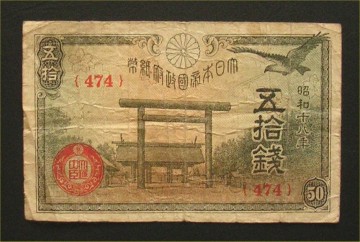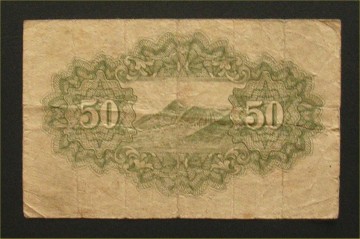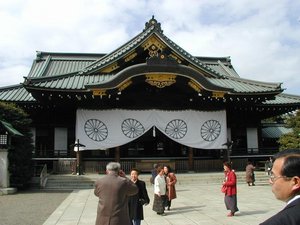 |
 |
Face value : 50 Sen 
Design : Yasukuni Shrine
Issue : 1942 - 1945 (Showa era, year 17-20), Abolition : August, 1948 (Showa era, year 23)
Size : 65mm X 105mm
|
 The Yasukuni Shrine (literally "peaceful nation shrine") is a controversial Shinto shrine located in Tokyo, Japan dedicated to the spirits of dead Japanese soldiers. As of October 2004, its Book of Souls lists the names of 2,466,532 Japanese and former colonial soldiers (mostly Korean and Taiwanese) killed in war. Also honored here are fourteen Japanese Class A war criminals, a fact which has engendered protests in a number of neighboring countries who believe their presence indicates a failure on the part of Japan to fully atone for its military actions during the first half of the 20th century.
The Yasukuni Shrine (literally "peaceful nation shrine") is a controversial Shinto shrine located in Tokyo, Japan dedicated to the spirits of dead Japanese soldiers. As of October 2004, its Book of Souls lists the names of 2,466,532 Japanese and former colonial soldiers (mostly Korean and Taiwanese) killed in war. Also honored here are fourteen Japanese Class A war criminals, a fact which has engendered protests in a number of neighboring countries who believe their presence indicates a failure on the part of Japan to fully atone for its military actions during the first half of the 20th century.
Controversy:
In the People's Republic of China, South Korea, Taiwan, North Korea and other victim nations of early 20th century Japanese military aggression, the shrine has become embroiled in controversy as a symbol of Japanese militarism of World War II, and a symbolic center of Japanese right-wing nationalism. Many peace groups in Japan also take issue with the shrine for similar reasons.
The shrine runs a museum on the history of Japan, commemorating soldiers who fought for Japan, which many outside observers has criticized as presenting a decidedly revisionist interpretation of history. A documentary-style video shown to museum visitors portrays Japan's conquest of East Asia during the pre-World War II period as an effort to save East Asia from the imperial advances of western powers. The museum's historic displays deny that events such as the Rape of Nanking took place, and systematically portrays Japan as a victim of foreign influence.
A pamphlet published by the shrine says "War is a really tragic thing to happen, but it was necessary in order for us to protect the independence of Japan and to prosper together with Asian neighbors." The shrine's English language website claims that "Japan's dream of building a Great East Asia was necessitated by history and it was sought after by the countries of Asia." The Japanese website claims that "comfort women were not forced to serve by the Japanese Empire. Koreans were not forced to change their names to Japanese ones." The shrine also points to atrocities committed by the Allied forces, such as the sinking of the Tsushima Maru, a transport ship torpedoed and sunk leading to the deaths over 1,500 people, of which 700 were elementary school children.
The shrine honors as kami those who died for the Emperor. This includes about 1,000 POWs executed for war crimes during World War II. This was not a political issue at the time, as Yasukuni was supposed to enshrine all Japanese war casualties. However, on October 17, 1978, fourteen Class A war criminals (according to the judgement of the International Military Tribunal for the Far East), including Hideki Tojo, were quietly enshrined as "Martyrs of Showa".
When revealed to the media on April 19, 1979, this started a controversy which rages to this day. The shrine has further angered many with its defiant defense of the war criminals; the same pamphlet mentioned above also claims: "Some 1,068 people, who were wrongly accused as war criminals by the Allied court, were enshrined here." The shrine's English-language website refers to those 1,068 as those "who were cruelly and unjustly tried as war criminals by a sham-like tribunal of the Allied forces." After the revelation of 1979, Emperor Hirohito stopped paying visits to the shrine, as his successor Emperor Akihito has also refrained from doing. However there are also strong voices among the Japanese people in support of visits by the Emperor, including Governor of Tokyo Shintaro Ishihara, who on August 15, 2004, indicated his strong hope for Emperor Akihito to start paying visits to the shrine.
|
Copyright © 2005-2020 Nippon Kindai Banknote. All Rights Reserved.
|